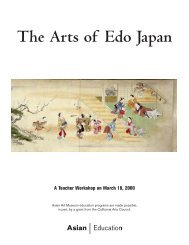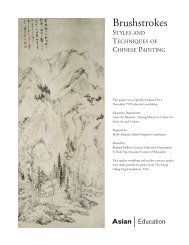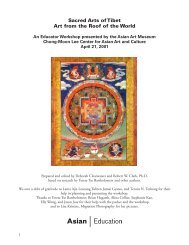China:The Glorious Tang And Song Dynasties - Asian Art Museum ...
China:The Glorious Tang And Song Dynasties - Asian Art Museum ...
China:The Glorious Tang And Song Dynasties - Asian Art Museum ...
You also want an ePaper? Increase the reach of your titles
YUMPU automatically turns print PDFs into web optimized ePapers that Google loves.
THE PORCELAIN INDUSTRY<br />
As with the industries of printing and paper making, the <strong>Tang</strong> and <strong>Song</strong> dynasties supported important<br />
industrial advances in pottery manufacture. <strong>The</strong> origin of porcelain pottery-making technology<br />
dates back 6000 years to the Neolithic period, and the related technologies and skills were continuously<br />
developed throughout early Chinese history. During the <strong>Tang</strong>, a systematic approach to the<br />
industry of pottery making marked a spectacular increase in quantity and quality of work. Porcelain<br />
kilns were constructed all over the country and improvements were instituted in nearly every aspect<br />
of production. By the time the industry had matured during the <strong>Song</strong>, porcelain was an indispensable<br />
item for daily use in all sectors of society and was exported by land and sea. By the eleventh century,<br />
it was being shipped to Japan, India, Arabia, Turkey, and Africa. <strong>The</strong> Portuguese began<br />
exporting porcelain directly to Western Europe in the sixteenth century, and by the late seventeenth<br />
century Europeans had developed a passion for porcelain “china.” Chinese artisans succeeded in<br />
keeping the technology for porcelain production secret from Europeans for two hundred years.<br />
Even after successful industrial espionage led to the rise of a European porcelain industry in the<br />
early eighteenth century, Chinese porcelain remained a popular import item.<br />
PORCELAIN MANUFACTURE<br />
Porcelain base is made from a combination of porcelain clay, orthoclase, and quartz. <strong>The</strong> external<br />
surface of a porcelain base is coated with vitreous glaze and the base is baked in a porcelain kiln at<br />
1200°C. <strong>The</strong> finished porcelain, after the baking process, has a very low water absorption coefficient<br />
(below 0.004) and is extremely hard. In addition to these practical strengths, porcelain is<br />
highly valued because of its beautiful glaze. Glazing is divided into two groups: underglaze and<br />
overglaze. Underglaze is applied to the porcelain base before it is baked. Overglaze is applied after<br />
the porcelain base is baked, when it is then rebaked with the glaze.<br />
Glaze created from a combination of mineral substances was originally invented in the Shang<br />
and Zhou dynasties (eleventh to tenth centuries BCE). <strong>The</strong> glazes produced in ancient <strong>China</strong> were<br />
generally green in color, until the Sui dynasty (581–618) when white glaze was first created.<br />
Manipulation of minerals to produce various colors can be observed in the use of iron in glaze production.<br />
Iron has two oxides: ferrous oxide (green color) and ferric oxide (dark brown or terracotta<br />
color). Iron in the glaze transforms into ferrous oxide when the baking process is a reduction reaction,<br />
and into ferric oxide when the baking process is an oxidization reaction. <strong>The</strong> final color of finished<br />
porcelain is determined by the percentage of iron in the glaze. <strong>The</strong> finished glaze is light green<br />
if the content of iron in the glaze is below 0.8%, and dark green if the iron is over 0.8%. When iron<br />
content exceeds 5%, the glaze will be dark brown or nearly black. <strong>The</strong> same principle applies similarly<br />
to other color agents. In the <strong>Tang</strong> dynasty, the porcelain industry was classified into green<br />
porcelains, mainly in north <strong>China</strong>, and white porcelains, mainly in south <strong>China</strong>.<br />
During the <strong>Song</strong> dynasty, comprehensive improvements were achieved in almost every aspect of<br />
the porcelain production cycle. <strong>The</strong> whole manufacturing process was standardized into several<br />
working procedures including base-making, glazing, ingredient control, and temperature maintenance.<br />
Each procedure was supervised by a specialist. In addition the industry was divided into five<br />
31
















